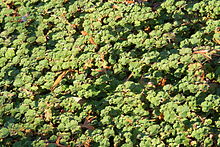- Rubus hayata-koidzumii
-
Creeping Raspberry 
Rubus calycinoides Scientific classification Kingdom: Plantae (unranked): Angiosperms (unranked): Eudicots Order: Rosales Family: Rosaceae Genus: Rubus Subgenus: Chamaebatus[citation needed] Species: R. hayata-koidzumii Binomial name Rubus hayata-koidzumii
Naruh..Synonyms Rubus hayata-koidzumii is probably better known by the (illegitimate) synonym Rubus calycinoides or as Creeping Raspberry. It is a low-growing member of the genus Rubus which also includes better known edibles such as the blackberry, raspberry, boysenberry, and thimbleberry.
Contents
History
Originally from Taiwan where it grows at high elevations.[2]
Uses
Plants are sometimes used to form a low growing, non-invasive, semi-evergreen to evergreen ground cover.[3][2]
Fruit/Flower
Like other plants in this genus, creeping raspberries bear aggregate fruits. What this means is that each "fruit" is actually a cluster of small fruit-like parts (pistils) connected together into one mass. Creeping raspberry fruits are similar in appearance to blackberries or red raspberries, but differ in that their color is yellow to orangish-red. The edible fruits follow white flowers which are borne in early summer.[3]
Pests/Diseases
There are no known pests or diseases which affect the creeping raspberry.[2][3]
Other names
The names Rubus pentalobus[4] and Rubus rolfei[5] are sometimes used in place of R. hayata-koidzumii or R. calycinoides. There are a number of other common names including "Crinkle-leaf Creeper",[4] "Taiwanese Creeping Rubus", and "Creeping Bramble", [2] but the plant is also often simply referred to by cultivar names such as 'Emerald Carpet'.[2]
References
- ^ GRIN taxonomy
- ^ a b c d e Perennial Ground Covers by David S. MacKenzie: Rubus calycinoides
- ^ a b c Washington State University: Rubus calycinoides
- ^ a b Oregon State University Department of Horticulture: Rubus calycinoides
- ^ Western Kentucky University: Rubus calycinoides
Categories:- Rubus
- Fruits originating in Asia
Wikimedia Foundation. 2010.
